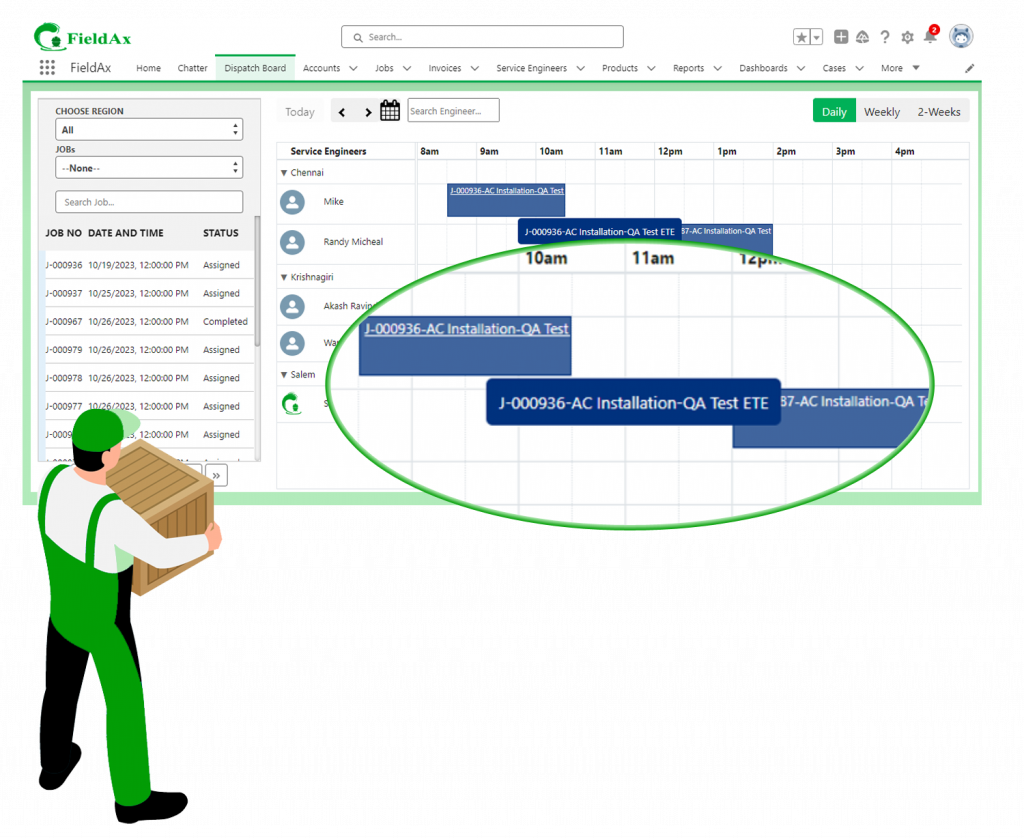Imagine a bustling day at a field service company, phones ringing off the hook with service requests pouring in from customers across the city. Each call represents a unique problem waiting to be solved – a malfunctioning appliance, a broken HVAC system, or a plumbing emergency. In the heart of this organized chaos lies a critical function: field service scheduling.
Field service scheduling is the invisible hand that orchestrates the timely deployment of technicians to address these pressing issues. It’s the art of matching the right engineer with the right skillset to the right job at the right time, all while balancing competing priorities and ensuring customer satisfaction. And like the conductor of a symphony, a well-executed scheduling strategy can transform what could be a cacophony of chaos into a harmonious symphony of service delivery.
In this blog post, we’ll delve into the world of field service scheduling, uncovering the top priorities that guide the allocation of field engineers to service requests. From assessing customer urgency to optimizing technician assignments based on geographic proximity, each priority plays a crucial role in streamlining operations and enhancing the overall customer experience. So, let’s embark on this journey together and explore the key strategies that define effective field service scheduling.

Key Takeaways:
Prioritizing customer urgency assessment ensures timely resolution of service requests, leading to enhanced customer satisfaction and loyalty.
Matching technicians’ skills with task requirements is essential for delivering high-quality service and minimizing the risk of errors or delays.
Geographic proximity optimization minimizes travel time for technicians, improving efficiency and reducing operational costs.
Effective management of equipment and parts availability prevents service disruptions and ensures smooth service delivery.
Workload balancing optimizes resource utilization and enhances productivity, leading to improved operational efficiency and employee satisfaction.
Efficient scheduling is crucial for maximizing operational efficiency, enhancing customer satisfaction, and driving business growth in the competitive field service industry.
1. Customer Urgency Assessment
Amidst the whirlwind of incoming service requests at the field service company, one aspect consistently takes precedence: customer urgency assessment. Picture this: a phone rings incessantly in the bustling office as urgent cries for assistance echo through the line. Each call represents a unique situation, a customer in need of immediate resolution to their pressing issue.
In the heart of this chaos, the customer service team plays a pivotal role. They’re tasked with swiftly evaluating the urgency of each request, discerning between routine maintenance inquiries and critical emergencies. With a keen ear for distress in the customer’s voice and a quick review of the details provided, they must make split-second decisions on how to prioritize these calls.
Consider a scenario where a customer reports a malfunctioning air conditioning unit in the midst of a scorching summer day. The sweltering heat exacerbates the urgency of the situation, making it imperative to address promptly to ensure the customer’s comfort and well-being. In contrast, a routine maintenance request for a non-essential appliance may be deemed less urgent and scheduled for a later date.
Customer urgency assessment isn’t just about fixing technical issues; it’s about alleviating the stress and inconvenience experienced by customers in their moment of need. By prioritizing urgent requests, field service companies demonstrate their commitment to delivering timely solutions and fostering trust and loyalty among their customer base. After all, in the world of field service scheduling, the customer’s urgency reigns supreme.
2. Technician Skill Matching
In the intricate dance of field service scheduling, the next spotlight falls on Technician Skill Matching. Imagine a scenario where a customer reports a complex issue with their industrial machinery, requiring specialized expertise to diagnose and repair. Here, the art lies in matching the intricacies of the task with the technical proficiency of the field engineer.
Matching skills with task requirements
Consider a situation where a factory grinds to a halt due to a malfunction in its machinery. The urgency is palpable, and a swift response is imperative. However, not just any technician will suffice. The task demands a specialist, someone well-versed in the intricacies of industrial machinery, capable of deciphering complex technical schematics and diagnosing intricate mechanical failures.
Identifying the most qualified engineer
In this high-stakes game of technician deployment, identifying the most qualified engineer is paramount. It’s about more than just matching skill sets; it’s about pinpointing the individual with the precise blend of expertise and experience to tackle the task at hand. Through meticulous evaluation and assessment, the field service team must ensure that the chosen engineer possesses the requisite knowledge and proficiency to deliver a swift and effective solution.
In the realm of Technician Skill Matching, the success of field service operations hinges on the ability to align task requirements with the expertise of the assigned engineer. It’s a delicate balancing act that requires careful consideration and meticulous attention to detail. But when executed seamlessly, it ensures that the right person is deployed to address each service request, ultimately driving customer satisfaction and operational excellence.
3. Geographic Proximity Optimization
As the field service company orchestrates its scheduling symphony, the spotlight now shines on Geographic Proximity Optimization. Picture a scenario where multiple service requests flood in from different corners of the city. Here, the challenge lies in efficiently allocating technicians to minimize travel time and maximize productivity.

Benefits of optimizing technician assignments based on location
Consider a bustling urban landscape, where navigating through congested streets and gridlocked traffic can add significant delays to technician dispatch. By strategically assigning technicians based on their proximity to service locations, the field service company can mitigate these challenges and expedite response times. This not only enhances operational efficiency but also improves customer satisfaction by ensuring timely service delivery.
Minimizing travel time
In the race against the clock, every minute saved on the road translates to valuable time gained in resolving customer issues. By minimizing travel time through geographic proximity optimization, field service companies can optimize resource utilization and maximize technician productivity. This strategic approach not only reduces fuel costs and vehicle wear and tear but also allows technicians to attend to a greater number of service requests within a given timeframe.
In the realm of Geographic Proximity Optimization, the key to success lies in leveraging technology and data-driven insights to make informed decisions about technician assignments. By prioritizing proximity and minimizing travel time, field service companies can streamline operations, enhance customer satisfaction, and drive business growth.
4. Equipment and Parts Availability
In the intricate tapestry of field service scheduling, the spotlight now shifts to Equipment and Parts Availability. Imagine a scenario where a technician arrives at a customer’s location only to discover that crucial equipment or parts are unavailable, bringing the service to a grinding halt. Here, the challenge lies in ensuring seamless coordination between scheduling and inventory management to avoid such pitfalls.
Impact of availability on scheduling
Consider a situation where a customer urgently requires a replacement part for their malfunctioning appliance. The success of the service visit hinges on the availability of this crucial component. A delay in obtaining the necessary part not only prolongs the customer’s inconvenience but also disrupts the technician’s schedule, leading to inefficiencies and potential customer dissatisfaction. By understanding the impact of equipment and parts availability on scheduling, field service companies can proactively address inventory gaps and optimize service delivery.
Coordinating with inventory management
In the fast-paced world of field service, effective coordination between scheduling and inventory management is essential. By maintaining real-time visibility into inventory levels and anticipating service demands, field service companies can ensure that technicians have access to the necessary equipment and parts when they need them most. This requires seamless integration between scheduling software and inventory management systems, enabling proactive replenishment of stock and minimizing the risk of service disruptions due to inventory shortages.
In the realm of Equipment and Parts Availability, the key to success lies in proactive planning and effective communication between scheduling and inventory management teams. By prioritizing availability and streamlining inventory processes, field service companies can optimize service delivery, enhance customer satisfaction, and drive operational efficiency.
5. Workload Balancing
In the intricate choreography of field service scheduling, the final act revolves around Workload Balancing. Imagine a stage where technicians await their cues, each with a unique set of skills and assignments. Here, the challenge lies in orchestrating a symphony of service requests, ensuring that workloads are balanced to maximize efficiency and productivity.
Balancing technicians’ workloads
Consider a scenario where some technicians find themselves overwhelmed with a deluge of service requests, while others have idle time waiting for assignments. This imbalance not only leads to inefficiencies but also affects employee morale and customer satisfaction. By prioritizing workload balancing, field service companies can optimize resource utilization, prevent burnout, and ensure equitable distribution of tasks among their workforce.
Strategies for workload distribution
In the quest for optimal efficiency, field service companies employ various strategies for workload distribution. This may include dynamic scheduling algorithms that take into account technician availability, skill sets, and geographic proximity to service locations. Additionally, proactive monitoring of service demand and adjusting technician assignments in real-time can help adapt to changing circumstances and prevent bottlenecks in workflow.
In the realm of Workload Balancing, the key to success lies in proactive planning and agile execution. By implementing effective strategies for workload distribution, field service companies can optimize resource allocation, enhance employee satisfaction, and deliver exceptional service to customers. It’s a delicate balancing act that requires careful coordination and continuous refinement to achieve operational excellence.
How does FieldAx streamline Field Service Scheduling?
In the realm of field service management, FieldAx emerges as a comprehensive solution that adeptly addresses the top priorities of efficient scheduling. Let’s explore how FieldAx handles each aspect with finesse:
Customer Urgency Assessment and Technician Assignment
FieldAx’s innovative dispatcher module empowers service managers to prioritize service requests based on urgency with ease. Through intuitive interfaces, managers can swiftly assess the urgency of each request and identify the nearest available technician equipped with the necessary skills to address the issue promptly.

Technician Skill Matching and Assignment
With FieldAx, matching technician skills to task requirements becomes a seamless process. Leveraging advanced algorithms, the software intelligently matches the required skill set with the expertise of available technicians. This ensures that each assignment is entrusted to the most qualified engineer, minimizing errors and enhancing service quality.
Geographic Proximity Optimization
FieldAx’s geographic proximity optimization feature revolutionizes technician assignment. By considering the location of each service request and the real-time availability of technicians, the software intelligently assigns tasks to nearby engineers. This minimizes travel time, maximizes efficiency, and ultimately boosts customer satisfaction.
Equipment and Parts Availability Management
FieldAx excels in managing equipment and parts availability within a single platform. Through seamless integration with inventory management systems, the software provides real-time visibility into stock levels and part availability. This enables service managers to proactively address inventory shortages and ensure smooth service delivery without delays.
Workload Balancing and Resource Utilization
FieldAx’s dynamic scheduling capabilities enable effective workload balancing and resource utilization. By analyzing technician availability, skill sets, and workload distribution, the software optimizes task assignments in real-time. This ensures equitable distribution of tasks, prevents technician overload, and maximizes operational efficiency.
With FieldAx, field service companies can streamline scheduling operations, enhance service delivery, and elevate customer satisfaction. By leveraging advanced features and intuitive interfaces, FieldAx empowers organizations to achieve operational excellence in today’s competitive landscape.
FAQs (Frequently Asked Questions)
1. How can I ensure fairness in technician assignments?
– Fairness in technician assignments can be ensured by implementing transparent criteria for task allocation, such as skill levels, workload distribution, and rotation schedules.
2. What tools or software can help streamline scheduling processes?
– Various field service management software solutions offer scheduling modules that automate and optimize technician assignments based on predefined criteria, enhancing efficiency and accuracy in scheduling.
3. How do I handle unexpected changes or emergencies in scheduling?
– Handling unexpected changes or emergencies in scheduling requires a flexible and responsive approach. Field service companies can designate backup technicians, implement contingency plans, and utilize real-time communication channels to address unforeseen events promptly.
4. What measures can be taken to improve communication between the scheduling team and field technicians?
– Improving communication between the scheduling team and field technicians can be achieved by implementing centralized communication platforms, providing mobile access to scheduling information, and establishing clear protocols for updating and sharing task assignments.
5. How do I track and analyze the performance of scheduling operations?
– Tracking and analyzing the performance of scheduling operations can be done through key performance indicators (KPIs) such as response times, service completion rates, and customer satisfaction scores. Utilizing reporting and analytics tools within field service management software can provide valuable insights for continuous improvement.
See how FieldAx can transform your Field Operations.
Try it today! Book Demo
You are one click away from your customized FieldAx Demo!
Conclusion
In the dynamic landscape of field service management, efficient scheduling serves as the backbone of successful operations. As demonstrated in this blog post, prioritizing customer urgency assessment, technician skill matching, geographic proximity optimization, equipment and parts availability, and workload balancing are essential strategies for optimizing scheduling processes and enhancing overall service delivery.
By leveraging these priorities and implementing best practices in scheduling, field service companies can improve operational efficiency, maximize resource utilization, and elevate customer satisfaction. Furthermore, embracing technology-driven solutions and fostering a culture of continuous improvement can position organizations for long-term success in the competitive field service industry.
As we conclude our exploration of effective field service scheduling, it’s evident that the journey towards operational excellence is an ongoing endeavor. By prioritizing efficiency, innovation, and customer-centricity, field service companies can navigate the complexities of scheduling with confidence, driving growth and differentiation in today’s rapidly evolving market landscape.
Author Bio
Co-Founder & CMO at Merfantz Technologies Pvt Ltd | Marketing Manager for FieldAx Field Service Software | Salesforce All-Star Ranger and Community Contributor | Salesforce Content Creation for Knowledge Sharing






